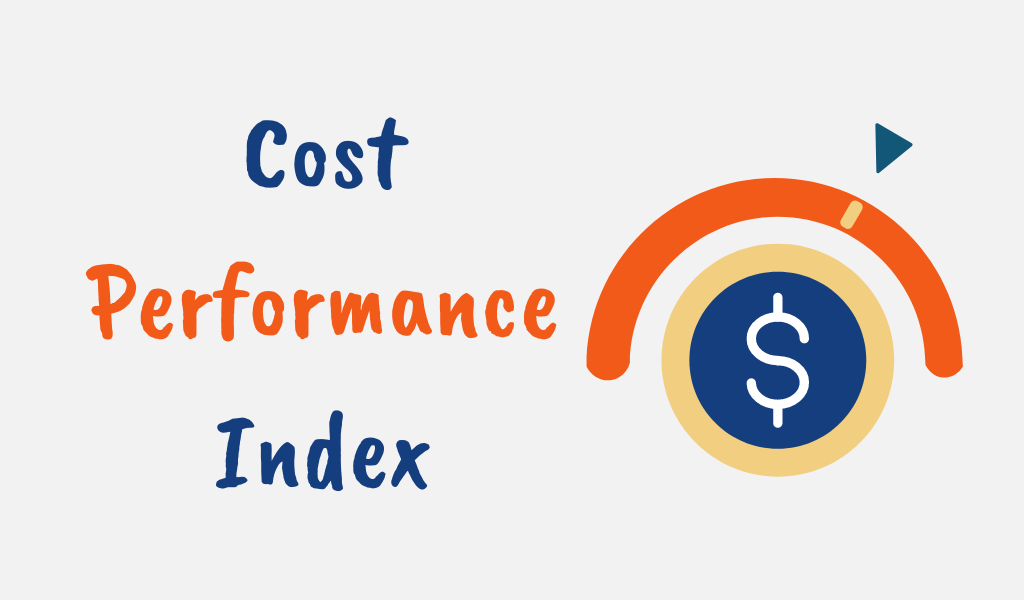Project management at a high level is all about value delivery. However, at a more detailed level, it involves delivering this value through a project of the required quality within the specified budget and timeline.
While it’s important to deliver a project of the required quality, it’s also important to do it within the stipulated schedule and cost constraints, otherwise, you can’t call that a project success.
Therefore it’s important when managing a project to continuously monitor the project’s performance using relevant metrics and quickly make corrections if you discover deviations.
The Cost Performance Index (CPI) is a key project management metric that can help in tracking the financial progress of your project and provides valuable insights into how well a project is performing in terms of cost efficiency.
This post dives into Cost Performance Index in project management, providing insight into its importance, how to calculate it, and how it helps you make better decisions as a project manager. The knowledge of CPI also comes in handy if you’re preparing for the Project Management Professional (PMP) certification exam as you can expect a few questions from there.
What is Cost Performance Index (CPI)?
Cost Performance Index (CPI) is an Earned Value Management (EVM) metric that measures the cost efficiency of a project.
It is calculated by dividing the Earned Value (EV) by the Actual Cost (AC). The Earned Value is the value of the completed work, while the Actual Cost is the actual cost incurred in completing the work.
CPI is a crucial metric in project management because it helps in assessing the project’s financial performance.
This way, potential problems are identified before they escalate and this gives an opportunity to take corrective actions.
If the CPI of a project is less than one, the inference is that the project is over budget, a CPI greater than one indicates that the project is under budget, and a CPI that’s equal to 1 is just on budget.

Cost Performance Index Formula
The formula for the Cost Performance Index (CPI) is a simple ratio given as:
CPI = EV / AC
where EV is Earned Value and AC is Actual Cost.
How to Calculate Cost Performance Index in Project Management
The Cost Performance Index (CPI) is calculated by measuring the ratio of the project’s Earned Value (EV) to the Actual Cost (AC) at a specific point in time.
CPI = Earned Value (EV) / Actual Cost (AC)
To calculate the Earned Value (EV), multiply the percent complete by the Budget at Completion (BAC) which is the total budgeted cost for the project.
Earned Value (EV) = Percent Complete x Budget at Completion (BAC)

Cost Performance Index Example
For further clarity, let’s use a project as an example. Let’s assume you’re managing a web development project with a total budget is $100,000, and the project schedule is 3 months.
If a project is 50% complete after 2 months, and the amount spent so far is $80,000, then the Earned Value (EV) would be:
Earned Value (EV) = 50% x $100,000 = $50,000
To calculate the Actual Cost (AC), add up all the costs incurred in completing the work. For this project, the Actual Cost (AC) = $80,000
Once you have calculated the Earned Value (EV) and Actual Cost (AC), you can plug them into the CPI formula to calculate the Cost Performance Index.
CPI = $50,000 / $80,000 = 0.625
From the CPI calculation for this project, it’s clear that the project is over budget and if it is to be completed within budget, some adjustments have to be done fast.
This video gives a practical example of how to calculate the Cost Performance Index.
Importance of Cost Performance Index (CPI) in Project Management
There are several reasons why the CPI is an important metric to track during a project including:
1. Identify Potential Problems Early
To start understanding the importance of the Cost Performance Index (CPI) in project management is to look at the example above.
As you can see, the CPI as a metric provides valuable insights into how efficiently resources are been used for a project.
This way, you can identify potential problems on time and know if your project is over budget so you can take corrective actions before it all goes downhill.
2. Aids in Forecasting
The CPI is a handy technique for forecasting the final project cost. If the CPI remains constant throughout the project, then the final cost can be estimated by multiplying the actual cost by the CPI.
This way, even during the project you can have an idea of what the final cost will look like if the project continues at that rate.
3. Helps in Making Data-Driven Decisions
The CPI provides objective data that can be used to make data-driven decisions. For example, if the CPI is consistently lower than 1.0, that’s an indication that the project is likely to be over budget.
To stay within the approved budget, a re-evaluation of the project’s scope, schedule, or resources may be necessary in order to improve the cost performance.
4. Improves Communication
Using the CPI helps in communicating the project’s cost performance in a clear and concise way.
It’s a simple metric that can easily be understood by the stakeholders, including project sponsors, customers, and team members.
5. Helps in Benchmarking
The CPI can be used to benchmark a project’s cost performance against similar projects or industry standards.
This helps to identify areas where the project team can improve and optimize cost performance.
Limitations of Cost Performance Index (CPI)
While the Cost Performance Index (CPI) is undoubtedly a valuable tool for analyzing project performance, it’s not without its limitations.
Let’s take a closer look at some of the main limitations of the CPI.
1. Limited Scope
A major limitation of the CPI is that it’s only concerned with project cost performance. While cost is undoubtedly an essential factor in project management, it’s however not the only one.
Other critical factors such as schedule performance, quality performance, and risk management can have a significant impact on project success.
Focusing solely on cost can lead to a narrow perspective on project performance, which can result in missed opportunities to identify and mitigate risks that may impact project success.
2. Dependence on Accurate Data
Another limitation of the CPI is that it relies heavily on accurate data. Calculating the CPI requires accurate data on the actual cost of work completed, the percentage of work completed, and the budgeted cost of work scheduled.
If any of this is incorrect and used to calculate the CPI is inaccurate or incomplete, the results will be misleading and could lead to incorrect decisions.
3. Vulnerability to Manipulation
The CPI is a metric that is often used to measure the performance of project managers, and as such, it is vulnerable to manipulation.
Project managers may be tempted to manipulate the data to make it appear that the project is performing better than it actually is.
This can be done by underestimating the actual cost of work completed or overestimating the budgeted cost of work scheduled.
Using Cost Performance Index to Make Better Decisions for Your Project
CPI is a powerful tool that can be used to make better decisions for a greater likelihood of project success.
A comparison of the CPI with the budget of the project will immediately provide clarification on whether the project is over or under budget.
If the CPI is less than one, then the project is over budget and you can take corrective actions such as reducing costs or increasing revenue.
If the CPI is greater than one, then the project is under budget and the remaining budget can be allocated to other projects or invested in additional resources to complete the project ahead of schedule.
Although in the actual world, it’s unlikely to have projects where the CPI happens to be exactly equal to one, it happens. In this case, the project is just on budget and care should be taken to maintain the cost performance.

Earned Value Management (EVM) and Cost Performance Index (CPI)
Earned Value Management (EVM) and the Cost Performance Index (CPI) are important metrics in project management that are closely related.
EVM is a technique that measures project performance by integrating project scope, cost, and schedule. It uses different metrics to do this.
CPI is one of the metrics that is used by EVM to measure the performance of the project. It measures the project’s cost efficiency and is used in calculating other metrics like the Estimate At Completion (EAC).
The Estimate At Completion (EAC) is an estimate of the final project cost based on the project’s current cost performance. The EAC can be calculated by dividing the budget at completion by the CPI.
Why Does the Cost Performance Index (CPI) Fluctuate?
The Cost Performance Index (CPI) which is a metric that measures a project’s cost efficiency can fluctuate for a variety of reasons.
For example, changes in scope, delays in the project schedule, unexpected expenses, and limited resources can all impact the CPI.
Inaccurate forecasting, poor cost management, and inadequate risk management can also contribute to fluctuations.
As a project manager, it’s crucial to understand why the CPI is fluctuating and take action to correct it.
Regular monitoring and analysis of the CPI can help anticipate potential issues and make informed decisions that improve cost performance.
What is the Cost Performance Index operating range?
The Cost Performance Index (CPI) operating range is typically between 0.0 and 1.0. This range helps in determining if the project is on budget, under budget, or over budget.
If the CPI is 1.0, it means that the project is on budget, and the value of the work performed equals the actual cost.
If the CPI is greater than 1.0, the project is under budget, and the value of the work performed is greater than the actual cost.
If the CPI is less than 1.0, the project is over budget, and the value of the work performed is less than the actual cost.
It’s important to note that the CPI is a ratio, and a value less than 1.0 doesn’t necessarily mean the project is failing.
However, if the CPI consistently stays below 1.0, it may indicate potential issues that require attention.
Conclusion
As a project manager, one of the most common questions you’ll hear from your project stakeholders is “What’s it gonna cost?”
Money is important everywhere and managing your project costs is too. If you want to manage your project from the initiation to the closing phase within budget, you have to monitor the costs.
The Cost Performance Index is crucial in doing this and I strongly advise you to learn and add it to your arsenal of project management techniques and tools.
FAQs
How Often Should the CPI be Calculated During a Project?
The CPI should be calculated at regular intervals during the project, such as weekly or monthly, in order to monitor the project’s financial performance and identify potential problems early.
What is the Difference Between the Cost Performance Index (CPI) and the Schedule Performance Index (SPI)?
The Cost Performance Index (CPI) measures the cost efficiency of the project, while the Schedule Performance Index (SPI) measures the schedule efficiency of the project.
The SPI is calculated by dividing the Earned Value (EV) by the Planned Value (PV).
Can the Cost Performance Index (CPI) be used to Evaluate the Performance of Individual Team Members?
No, the CPI is a metric that evaluates the overall cost efficiency of the project and cannot be used to evaluate the performance of individual team members.
Other metrics such as individual performance reviews and team assessments should be used for this purpose.





